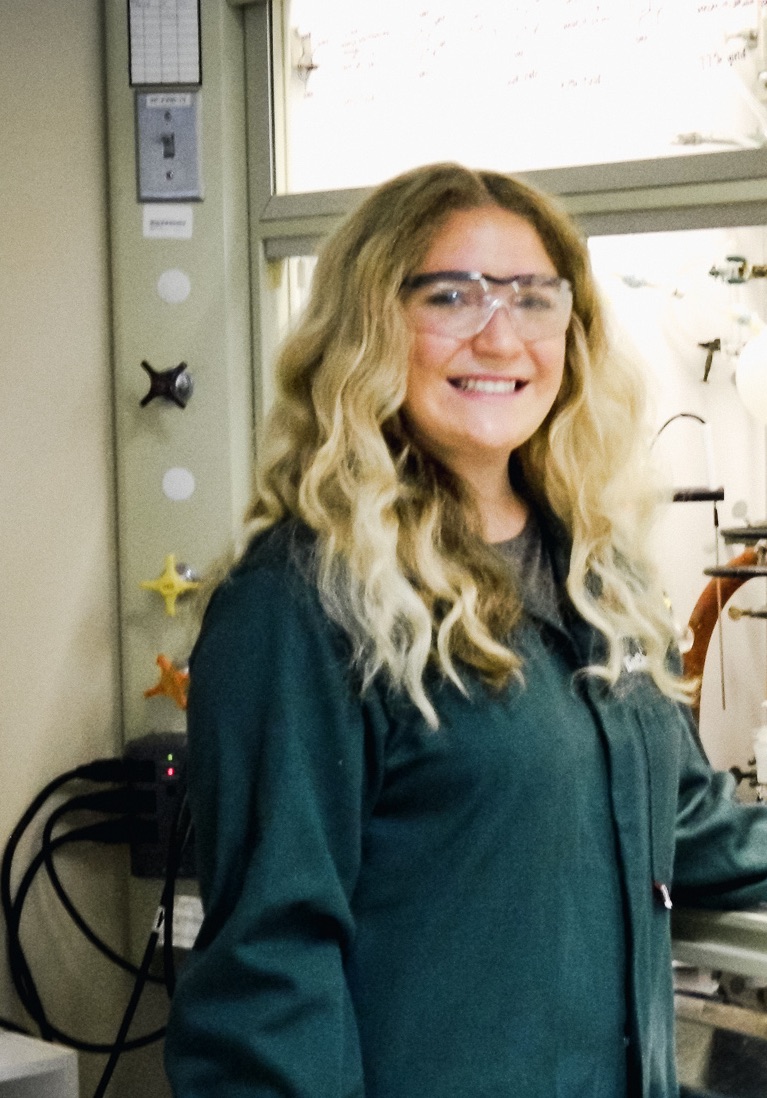Org. Synth. 2018, 95, 455-471
DOI: 10.15227/orgsyn.095.0455
Synthesis of Acyl Derivatives of Cotarnine
Laxmidhar Rout,
1#* Bibhuti Bhusan Parida,
# Ganngum Phaomei,
# Bertounesque Emmanuel,
€ and Akhila Kumar Sahoo
&
Checked by Lee Mains, Lauren Markham, Austin Medley, and John L. Wood
1. Procedure (Note 1)
A.
Cotarnine (1). A 250-mL, round-bottomed, three-necked flask is equipped with a magnetic stir bar (elliptical, 32 x 16 mm, Teflon-coated). The flask is dried under vacuum (1.8 mmHg) with a propane torch and then allowed to cool to 25 °C. The dried flask is then charged with
nitric acid (150 mL, 18% (v/v) in H
2O) and fitted with a reflux condenser complete with a nitrogen inlet, a thermometer, and the final neck is sealed with a rubber septum (Figure 1) (Notes
2, and
3). Slow stirring of the solution (150 rpm) is commenced. The rubber septum is briefly removed, the solid
(S,R)-Noscapine (20 g,
48.4 mmol, 1.0 equiv) is added to the flask in a single portion at 25 °C, after which the rubber septum is replaced (Notes
4 and
5). The mixture is observed to turn from a white to slightly yellow turbid solution. (Figure 1).
Figure 1. Experimental set-up and addition of (2S,3R)-noscapine
The flask is then lowered into a pre-heated oil bath maintained at 50 °C (
Note 6) with the internal temperature monitored throughout the reaction
via the thermometer. The mixture forms a yellow mixture upon heating and dissolves completely at 38 °C. During the reaction, a series of color changes are observed: the solution changes color from yellow to brown, then brown to red, and finally red to yellow (
Note 7). Upon completion of the reaction, the mixture consists of a yellow solution and a white precipitate, which gradually forms during the course of the reaction (
Note 8) (Figure 2).
Figure 2. Yellow solution and white precipitate upon completion of the reaction
No more starting material is observed by TLC (
Note 9) after 1.5 h, and the reaction flask is removed from oil bath and cooled to 25 °C. A 1-L filter flask is equipped with a sintered glass Büchner funnel (150 mL, 6.7 cm diameter, coarse porosity) and connected to a vacuum source (5 mmHg, 24 °C) for filtration. The mixture is poured through the filtration set-up to remove the precipitate. The collected precipitate is washed with distilled water (3 x 5 mL) and eventually discarded. The Büchner funnel is then removed and the 1-L filter flask containing the yellow filtrate is submerged in an ice-water bath (0 °C). A large magnetic stir bar (polygon, 51 x 8 mm Teflon-coated) is added to the filter flask along with a thermometer to monitor the internal reaction temperature, and continuous stirring is initiated (200 rpm). A 150-mL addition funnel containing an 40% (wt/wt) aqueous solution of
KOH (140 mL) (
Note 10) is positioned over the filter flask and the
KOH solution is added dropwise over 25 min (Figure 3).
Figure 3. KOH addition to the filtrate
An exotherm is observed upon addition of the
KOH solution, thus the ice-water bath is employed to maintain the temperature ≤ 20 °C. A precipitate (the desired product) is formed over the course of the reaction. Upon reaching a
pH = 11, the reaction is deemed complete as no additional precipitation is observed (
Note 11). A sintered glass Büchner funnel (150 mL, 6.8 cm diameter, coarse porosity) is fitted to a 1-L filter flask and equipped for vacuum filtration. The reaction mixture is poured through the filtration set-up to collect the crude yellow precipitate. The crude yellow solid is washed with cold (0 °C) distilled water (4 x 5 mL), followed by additional washes with water (4 x 10-mL (60 mL total). The yellow microcrystalline product is dried under high vacuum (1.8 mmHg, 25 °C) for 3 h to afford 9.85 g (87 %) of
cotarnine (1) (Figure 4). The obtained product is highly pure (>99%) as established by qNMR and is used directly for Step B (Notes
12 and
13).
Figure 4. Isolated cotarnine (1)
B.
2-(4-Methoxy-6-methyl-5,6,7,8-tetrahydro-[1,3] dioxolo[4,5-g]iso quinol in-5-yl)-1-phenylethan-1-one (3a). A 50-mL round-bottomed flask is equipped with a magnetic stir bar (elliptical, 22 x 12 mm, Teflon-coated). The flask is dried under vacuum (1.8 mmHg) with a propane torch and then allowed to cool to 25 °C. The dried flask is charged with
cotarnine (1) (4.74 g, 20 mmol, 1.0 equiv) and dissolved in distilled
methanol (10 mL) under nitrogen. The resultant mixture is stirred (300 rpm) for 5 min to allow for homogeneity resulting in an opaque, orange solution. (Figure 5).
Figure 5. Cotarnine dissolved in MeOH
Acetophenone (2.48 mL, 2.4 g, 20 mmol, 1.0 equiv) is added dropwise
via syringe to the solution over the course of 2-5 min, and formation of a white precipitate is observed after
ca. 10 min (
Note 14). Stirring is continued for an additional 15 min to ensure completion of the reaction (25 min total) (Figure 6).
Figure 6. Precipitate formation 10 minutes after addition of the acetophenone
The white precipitate is isolated by gravity filtration through a Büchner funnel (115 mL, 6.6 cm diameter) containing filter paper (Whatman 40, 70 mm diameter). The crude solid is washed with cold (0 °C)
methanol (10 x 2 mL) and dried under vacuum (25 °C) on the Büchner funnel, then transferred to a 50 mL round-bottomed flask and dried under high vacuum (1.8 mmHg, 25 °C) for 1 h to afford 5.85 g (86%) of
3a as a white microcrystalline solid (Figure 7). Purity of the product is assessed at >98% by qNMR analysis (Notes
15 and
16).
Figure 7. Isolated product 3a
2. Notes
1. Prior to performing each reaction, a thorough hazard analysis and risk assessment should be carried out with regard to each chemical substance and experimental operation on the scale planned and in the context of the laboratory where the procedures will be carried out. Guidelines for carrying out risk assessments and for analyzing the hazards associated with chemicals can be found in references such as Chapter 4 of "Prudent Practices in the Laboratory" (The National Academies Press, Washington, D.C., 2011; the full text can be accessed free of charge at
https://www.nap.edu/catalog/12654/prudent-practices-in-the-laboratory-handling-and-management-of-chemical . See also "Identifying and Evaluating Hazards in Research Laboratories" (American Chemical Society, 2015) which is available via the associated website "Hazard Assessment in Research Laboratories" at
https://www.acs.org/content/acs/en/about/governance/committees/chemicalsafety/hazard-assessment.html. In the case of this procedure, the risk assessment should include (but not necessarily be limited to) an evaluation of the potential hazards associated with (
(2S, 3R)-Noscapine, concentrated nitric acid, cotarnine, acetophenone, methanol, potassium hydroxide ,
acetone,
ethyl acetate,
1,4-diiodobenzene and
formic acid as well as the proper procedures for
flame drying glassware and vacuum filtration.
2.
(S,R)-Noscapine (97%), concentrated
nitric acid (69% (wt/wt);
KOH pellets (EMPLURA brand by EMD Millipore),
acetophenone (99%, ACS reagent grade);
1,4-diiodobenzene (99%), deuterated chloroform (99.8 atom% deuterated); and glass-backed, extra-hard layer TLC plates (60 Å, 250 μm thickness containing F-254 indicator by EMD Millipore) were all purchased from Sigma-Aldrich and were used as received.
3. The 18% (v/v) aqueous
nitric acid stock solution is obtained from concentrated
nitric acid (69% (wt/wt) in H
2O) by dilution (N
1V
1=N
2V
2). To a 250 mL volumetric flask, 170 mL of distilled water is added, followed by 65.2 mL of 69% concentrated
nitric acid and an additional 14.8 mL of distilled water to bring the meniscus of the solution to the appropriate line on the volumetric flask.
4.
Noscapine is not fully soluble in the reaction medium at room temperature, but upon heating and reaching an internal temperature of 38 °C (
ca. 5-10 min after immersion in the oil bath) full dissolution occurs.
5. To avoid evaporation of
nitric acid solution (which may change the
HNO3 concentration), a condenser with a nitrogen inlet and cooled water circulation is employed until the reaction is complete.
6. The temperature is maintained below 50 °C, and the submitters state that care should be taken to maintain the reaction temperature between 50-55 °C. The submitters reported that the reaction temperature increases to 80 °C upon the formation of the precipitate; however, the checkers did not observe this temperature increase, as the maximum internal temperature reached was 48 °C.
7. These color changes occur over a 10-30 minute time period and a white precipitate (by-product) is observed after 30-35 minutes of heating (Figure 8).
Figure 8. Color change throughout heating the Noscapine in HNO3, A. Before heating, B. After 10 minutes, C. After 15 minutes, D. Color change and initial precipitate formation after 30 minutes
8. The precipitate begins to form
ca. 20 min into the reaction.
9. The yellow color of the solution is observed at the extreme end of the reaction, at which point, no more precipitate is observed to form. The TLC analysis was performed on an
acetone solution of the starting material and an aliquot (~2 drops) of the reaction mixture using a solution of EtOAc/MeOH (1:3) containing 1% formic acid as eluent and visualized with ceric ammonium molybdate (CAM) stain. Under these conditions, the product was observed to have an R
f=0.28 (Figure 9).
Figure 9. TLC of the noscapine with nitric acid and stained with CAM stain (Left: Front of TLC plate, Right: Back of TLC plate); Lane 1: starting material; Lane 3: reaction mixture; Lane 2: co-spot
10. Preparation of 40% (wt/wt)
KOH solution: In a 200 mL volumetric flask that contains 100 mL of distilled water, 80 g of solid
KOH pellets was added in two 40 g portions. After dissolution, additional distilled water is added to bring the meniscus of the solution to the appropriate line on the volumetric flask.
11. A precipitate is formed after addition of
potassium hydroxide.
Figure 10. Precipitate crashing out of solution at pH 11 upon completion of reaction
12. Yellow crystalline solid. mp 126-128 °C;
1H NMR
pdf(600 MHz, CDCl
3) δ: 2.33-2.36 (m, 1H), 2.59 (s, 3H), 2.60-2.64 (m, 1H), 2.84-2.91 (m, 1H), 3.06 (td,
J =11.5, 4.2 Hz, 1H), 4.04 (s, 3H), 5.41 (s, 1H), 5.88 (s, 2H), 6.31 (s, 1H);
13C NMR
pdf(150 MHz, CDCl
3) δ: 29.0, 41.1, 43.6, 59.8, 79.2, 100.9, 102.7, 122.5, 129.0, 134.2, 140.6, 149.1; HRMS (ESI) C
12H
14NO
3 [M-wOH]
+: calc. 220.0968, found 220.0967; FTIR (neat, ATR) 3082, 2953, 2870, 1617, 1477, 1445, 1261, 1091, 1036, 1091, 1036, 982, 970, 932, 791 cm
-1; R
f=0.23, eluent: EtOAc: MeOH (3:7) with 1% formic acid. The purity of the compound was calculated by qNMR
pdf with a delay of relaxation of 30 seconds using 11.4 mg of
1,4-diiodobenzene (purity 99%) and 8.2 mg of
cotarnine (1) and was found to be of 99.4% purity.
13. A reaction performed on half scale provided 5.02 g (88%) of the identical product.
14. In most of the cases, the product precipitated during 10 min of stirring. If a precipitate does not appear in 5-10 min, precipitation can be induced
via addition of a "seed crystal". This material is prepared in a separate 5-mL vial by reacting 0.5 mmol of
cotarnine and 0.5 mmol of
acetophenone in 0.5 mL
methanol. A crystal is removed from the solution by use of a spatula and placed into the reaction mixture to facilitate crystallization.
15. White crystalline solid. mp 124-125 °C;
1H NMR
pdf(600 MHz, CDCl
3) δ: 2.37 (s, 3H), 2.41-2.47 (m, 1H), 2.75-2.80 (m, 1H), 2.85-2.92 (m, 1H), 3.10-3.27 (m, 3H), 3.94 (s, 3H), 4.47 (dd,
J = 8.6, 3.9 Hz, 1H), 5.86 (s, 2H), 6.32 (s, 1H), 7.46 (t,
J = 7.5 Hz, 2H), 7.54 (t,
J = 6.9 Hz, 1H), 8.01 (d,
J = 8 Hz, 2H);
13C NMR
pdf(150 MHz, CDCl
3) δ: 23.9, 42.0, 43.7, 44.6, 55.2, 59.3, 100.6, 102.7, 122.4, 128.2, 128.4, 128.6, 132.7, 134.0, 137.4, 140.3, 147.9, 199.0; HRMS (ESI)
C
20H
22NO
4, [M+H]
+: calc. 340.1549, found 340.1546. FTIR (neat, ATR) 2915, 2838, 2794, 1678, 1619, 1597, 1498, 1318, 1283, 1257, 1062, 1041, 766, 696 cm
-1; R
f=0.84, eluent: EtOAc/MeOH (3:1). The purity of the compound was calculated by qNMR
pdf with a delay of relaxation of 30 seconds using 12.5 mg of
1,4-diiodobenzene (purity 99%) and 10 mg of product
3a and was found to be of 98.1% purity.
16. A reaction performed on half scale provided 2.78 g (82%) of the identical product.
Working with Hazardous Chemicals
The procedures in
Organic Syntheses are intended for use only by persons with proper training in experimental organic chemistry. All hazardous materials should be handled using the standard procedures for work with chemicals described in references such as "Prudent Practices in the Laboratory" (The National Academies Press, Washington, D.C., 2011; the full text can be accessed free of charge at
http://www.nap.edu/catalog.php?record_id=12654 ). All chemical waste should be disposed of in accordance with local regulations. For general guidelines for the management of chemical waste, see Chapter 8 of Prudent Practices.
In some articles in Organic Syntheses, chemical-specific hazards are highlighted in red "Caution Notes" within a procedure. It is important to recognize that the absence of a caution note does not imply that no significant hazards are associated with the chemicals involved in that procedure. Prior to performing a reaction, a thorough risk assessment should be carried out that includes a review of the potential hazards associated with each chemical and experimental operation on the scale that is planned for the procedure. Guidelines for carrying out a risk assessment and for analyzing the hazards associated with chemicals can be found in Chapter 4 of Prudent Practices.
The procedures described in Organic Syntheses are provided as published and are conducted at one's own risk. Organic Syntheses, Inc., its Editors, and its Board of Directors do not warrant or guarantee the safety of individuals using these procedures and hereby disclaim any liability for any injuries or damages claimed to have resulted from or related in any way to the procedures herein.
3. Discussion
The tetrahydroisoquinoline family of alkaloids exhibit a broad range of biological properties such as anti-tumor and anti-microbial activities.
2 Within this family, the anti-tussive drug
(S,R)-noscapine and its analogues display anti-tumor activity by impairing tubulin polymerization without severe side effects.
2,3 In addition, noscapine causes mitotic arrest of tumor cells, induces apoptosis of tumor cells
in vivo, and is in phase I/phase II clinical trials for multiple myeloma.
4Cotarnine is the central core of noscapine and is documented to have hemostatic activity.
5 Further,
cotarnine is the key component of tritoqualin (inhibostamin®) which is used as an anti-allergic drug,
6,7 and has been shown to have a preventive effect on liver injury in rats induced by treatment with CCl
4.
8
It is significant that the synthesis of 2-methyl-1-(2-oxo-aryl)-1,2,3,4-tetrahydroisoquinolines and their biological applications have been scarcely documented in literature.
9 Hence, derivatization of
cotarnine could pave the way to simplified noscapine analogues as potential anticancer agents.
8 Importantly, quaternized tetrahydroisoquinolines were synthesized from cotarnine iminium methyl sulfate (prepared in multiple steps from 3,4,5-trihydroxybenzoic acid), and their biological activities were investigated (Table 1).
10 Thus, various biological activities have been found such as filamin a-binding anti-inflammatory analgesic,
10a inhibition of tau phosphorylation,
10b and inhibition of growth of cancer cells.
10cGreen chemistry is being used in fine chemical and pharmaceutical industries to reduce waste, reduce costs and develop environmentally benign processes.
11 Chemical synthesis from laboratory to industrial level differs with respect to reaction scale, reproducibility of methodology, product purity, atom economy, cost and
E-factor of the process.
12,13 Herein we disclose the reaction of
cotarnine and aryl ketones in green solvents to synthesize gram quantities of 1,2,3,4-tetrahydroisoquinolines in excellent yields. The reaction is simple and requires no metal catalyst. The reaction takes place under base-free and metal-free conditions at room temperature in short reaction times. The products were isolated by simple filtration without work-up. The methodology was developed on the basis of structural similarity of
cotarnine derivatives with noscapinoids, which represent an emerging class of microtubule-modulating anticancer agents.
14
Table 1. Synthesis of some representative examples of cotarnine on gram scale as described in procedure B (Previous work)14
Conditions: The conditions are consistent with those described in Step B of this
Organic Syntheses procedure with similar scale. The yields are based on the isolated material obtained after gravity filtration.
14
Appendix
Chemical Abstracts Nomenclature (Registry Number)
(S, R)-Noscapine; (128-62-1)
Nitric Acid; (7697-37-2)
Acetophenone; (2a) (98-86-2)
Potassium Hydroxide; (1310-58-3)
1,4-Diiodobenzene; (624-38-4)
Cotarnine: 5, 6, 7, 8-Tetrahydro-4-methoxy-6-methyl-1, 3-dioxolo[4, 5-g]isoquinolin-5-ol; (1) (82-54-2)
2-(5,6,7,8-Tetrahydro-4-methoxy-6-methyl-[1,3]dioxolo[4,5-g]isoquinolin-5-yl)-1-phenylethanone; (3a) (2220-06-6)

|
Laxmidhar Rout was born in small village Kismat Krushnapur, Basudevpur, Bhadrak in 1976. He graduated in 1997 from A.B. College Basudevpur, Bhadrak. After earning a M. Sc. from Utkal University in 2003 with Prof S. Jena, he completed his Ph. D. with Prof. T. Punniyamurthy in IIT Guwahati in synthetic organic chemist in 2008. He worked as a postdoctoral associate with Prof. A. M. Harned in Minnesota and Prof. C-G. Zhao in University of Texas. He was awarded a Humboldt (AvH) fellowship in Germany in 2011-2013 with Prof. S. M. Huber in Technical University Munich and in the Institute of Curie Paris with Dr. E. Bertounesque. Since 2014, he has been working as an Assistant Professor in Berhampur University Odisha, India. His research interest is organic synthesis and drug discovery. |

|
Bibhuti Bhusan Parida received his M. Sc. degree from Utkal University-Bhubaneswar with advanced organic chemistry as his specialization. He qualified via national level entrance examinations CSIR-JRF and GATE to pursue a Ph. D. in synthetic organic chemistry at Indian Institute of Chemical Technology (CSIR-IICT)-Hyderabad under the supervision of Dr. S. Chandrasekhar (Director, IICT). Subsequently, he has over 7-years of post-Ph.D. research experiences including postdoctoral research at Wayne State University (Detroit, Michigan-USA), Institute Curie (Paris-France), teaching at IIIT-Bhubaneswar. Currently, he is working as an Assistant Professor at Berhampur University, Odisha. |

|
Emmanuel Bertounesque received his Ph.D. in synthetic organic chemistry from the University of Paris VII (ITODYS) in 1987, under the supervision of Professor Jacques Emile Dubois. He did his post-doctoral research in total synthesis of natural products at the University of Pennsylvania with Professor Amos B. Smith, III. He joined ESPCI Paris as a tenured researcher in the Simon Group and subsequently moved to Institut Curie - CNRS UMR 176 as a medicinal chemist in oncology drug discovery, in collaborations with Pierre Fabre Laboratories and Servier. He is currently involved in new therapeutic developments against Shiga toxin-producing Escherichia coli infection in the Chemical Biology of Membranes and Therapeutic Delivery Unit (UMR3666/U1143) of Dr. Ludger Johannes at Institut Curie. |

|
Akhila Kumar Sahoo received his masters from Utkal University Odisha in 1994. He completed Ph.D. with Prof G. Pandey in NCL Pune, after which he started working as a postdoctoral fellow with Prof. Hans-Joachin Gais in RWTH Germany. He worked with Prof. T. Hyiama at Kyoto University on a JSPS Fellowship. After service as a postdoc with Prof. K. Osuka in Kyoto University he joined the University of Hydrabad as an Assistant Professor in 2007. He has been working as a full Professor from 2016 in the field of organic synthesis. |

|
Dr. Ganngam Phaomei received his M.Sc. degree from Jamia Millia Islamia, New Delhi, India and Ph.D. from Manipur University, Imphal, India with Prof. W.R. Singh. He has research interests in nanotechnology, rare earth luminescence nanomaterials and functionalized nanomaterial. During his Ph. D, research he worked jointly with Dr. R. S. Ningthoujam, Scientist F, BARC, Mumbai, India and as a Research Associate in DST, India research project under Prof. N. Rajmuhon Singh at Manipur University,. He is currently working on nano-drug delivery. |

|
Lee Mains was born in Newcastle, England in 1992. He received his BSc (Hons) in Biopharmaceutical Science from University of Sunderland in 2016. He is currently a doctoral student under the direction of Prof. John L. Wood at Baylor University with research interests in natural product total synthesis. |

|
Lauren Markham was born in Arlington, Texas in 1998. She graduated from Keller High School in Keller, Texas in 2016. She currently attends Baylor University in pursuit of a B.S. in Chemistry to be completed in 2019. As an undergraduate research student, Lauren has worked on synthesizing 8-bromoguanosine analogs under the direction of Dr. Jesse W. Jones, and she currently is a member of Dr. John L. Wood's organic synthesis research group. |

|
Austin Medley is a native-born Texan, who moved to Canada at a young age. Currently, he works in the research group of John L. Wood as an undergraduate organic synthetic researcher at Baylor University. |
Copyright © 1921-, Organic Syntheses, Inc. All Rights Reserved